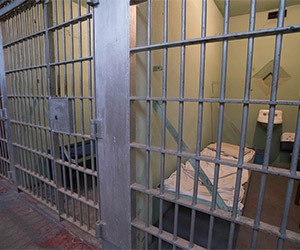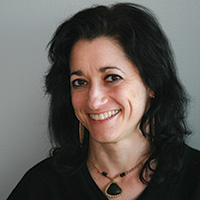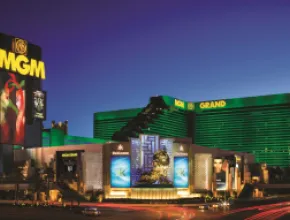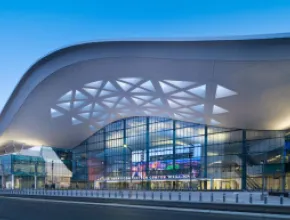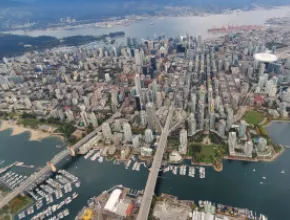“When you are raised by sock puppets you can be socially awkward.”
Not something I can actually visualize, but that is part of the strategy used in breeding endangered California condors to make a comeback, according to my guide Tate Mason, director the World Center for Birds of Prey. The center, located in Boise, Idaho, is the headquarters for the Peregrine Falcon Fund.
The nonprofit fund was founded in 1970 and played a pivotal role in the recovery of peregrine falcons. Today the center is home to the world’s largest captive flock of California condors, as it works to boost that population back in the wild.
My tour there was part of a recent three-day fam to Boise highlighting the unique and unexpected side of the city.
Mason walked us past enclosures with ornate hawk-eagles, bateleur eagles, turkey vultures and more. The star of the show was Gus, a 16-year-old peregrine falcon, which is the fastest species on the planet—flying at about 240 mph!
“The birds we have were injured in the wild,” Mason said. “We are not a hospital, but we give them a home and are ambassadors for their species.”
Groups can use the outdoor and indoor areas at the center for events.
Aside from the center, our fam toured some of Boise’s most indelible attractions on foot and by trolley, including a walk through the compact downtown punctuated by the stately Idaho State Capitol Building, which can host events. The Inn at 500, our host hotel, afforded straight sightlines to the Capitol.
Our group strolled past art galleries, cafes and toured the recently expanded Boise Centre. Despite a fall chill, we tucked into STIL (Sweetest Things In Life) in downtown’s trendy BoDo district. The ice-cream shop showcases home-made flavors using local ingredients. Beer and wine floats are also on order.
We stopped into several meetings-friendly hotels during the stay, including Grove Hotel, Hyatt Place Downtown and the new Residence Inn Downtown Boise/City Center. Lunch our first afternoon was at the Riverside Hotel, aka the music hotel, as it features live local music every day.
The hotel is located along the Boise River Greenbelt, a stretch of 25 miles of mostly paved trails. Its highlights include Julia Davis Park, home to the Idaho State Museum, Idaho Black History Museum, Zoo Boise and the Boise Art Museum, which celebrated its 80th anniversary last year.
Telaya Winery, also on the Greenbelt, greeted our group with a tasting of Idaho and Washington whites and reds. The boutique winery can be rented evenings or offers private space.
Though I had expected a green setting in the “City of Trees,” I had not heard about the famed Boise State Broncos blue turf at group-friendly Albertsons Stadium, where we stopped for selfies.
I also had not read about the infamous Old Idaho Penitentiary—its youngest inmate was just 10 years old. We toured solitary confinement, cell blocks and the gallows, and even saw the charred building marks where inmates attempted to burn the building down.
Now a museum, groups can host events at the Women’s Ward and main yard, among other spaces.
Another Boise surprise—it is home to one of the largest Basque populations outside of Spain and the only Basque museum in the country. We started with olive tapenade, cheese and wine at the Basque Market, snacking under a giant hanging paella pan.
“Many came here from small family farms or fishing villages,” said our guide, Dan Aizpitarte, his family included.
We toured the 1864-built Cyrus Jacobs-Uberuaga House boardinghouse, now the Basque Museum and Cultural Center. Groups can arrange a Basque Block party, hire Basque dancers and rent the Center.
Another tidbit we learned is that Idaho elected the first Jewish governor in the U.S., Moses Alexander (1915-1919). Still, Boise seems an unlikely spot for a prominent Anne Frank Human Rights Memorial. The sculptor cast a life-size statue of her as if she were looking out a window from the family's attic hiding place.
Our guide Dan Prinzing explained that in 1995 a traveling exhibit on Anne Frank drew in tens of thousands of visitors from around Idaho, sparking the idea for a more permanent tribute.
The memorial was built by the Idaho Human Rights Education Center (now the Wassmuth Center, named after activist Bill Wassmuth) and opened in 2002. More than 60 quotes from the world’s humanitarian leaders are etched into the walls around the statue.
Our final soft adventure was a white-water rafting trip with Cascade Raft and Kayak down the Main Payette River—the perfect ending to take in Boise’s vast expanse.
Contact Information
Boise CVB
208.344.7777



